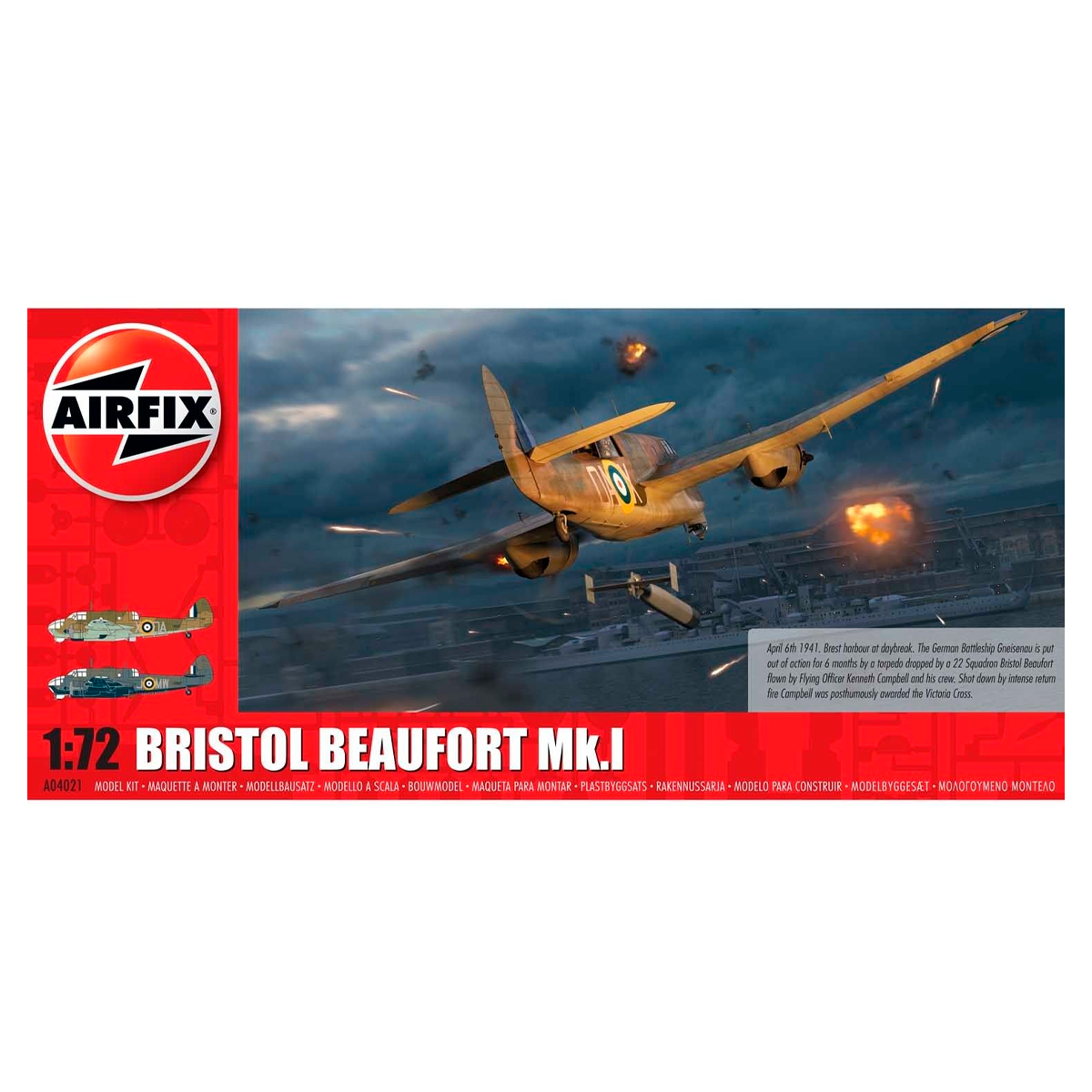Bristol Beaufort Mk1 1/72
30,95€
Solo quedan 1 disponibles

*Please check our Privacy Policies to see how to we use your personal data.
*Por favor revisa nuestra Política de Privacidad para ver como tratamos tus datos personales
The second in a successful trio of twin engined aircraft designed by the Bristol Aeroplane Company during the 1930s, the Beaufort is significant as the only monoplane produced for the Royal Air Force designed from the outset as a torpedo bomber and reconnaissance platform. Developed from the Blenheim light bomber, the Beaufort was ordered off the drawing board by the Air Ministry, a move which showed great faith in the Bristol Company whilst illustrating the RAF’s urgent need for an effective torpedo bomber at the same time.
Although initially intended as an evolutionary adaptation of the existing Blenheim bomber, it quickly became apparent that the new aircraft would look significantly different from its predecessor, with a much deeper front fuselage section housing a crew of four and the ability to carry a torpedo in a semi-recessed configuration. These modifications resulted in a gross weight increase of around 25% over that of the Blenheim and would require the installation of more powerful engines, if the new aircraft was not to suffer a significant performance reduction indeed, the new engines for the aircraft, combined with the existing production commitments for the Blenheim would cause lengthy delays during the Beauforts development. With the initial contract placed in August 1936, despite the pressing need for the new aircraft, it would be more than two years before the prototype Beaufort took to the air.
Entering Royal Air Force service with No.22 Squadron Coastal Command in January 1940, the Beaufort proved to be a rugged and highly manoeuvrable aircraft, although the engines continued to be something of a problem. Initially employed laying mines in enemy waters, Beauforts would later mount attacks against the German battleships Scharnhorst and Gneisenau and the heavy cruiser Prinz Eugen. However, in the European theatre, the aircraft would operate in the main as a medium bomber. In the Mediterranean, Beauforts operating from Egypt and Malta would take a terrible toll of Axis shipping and during a concerted onslaught from the middle of 1942, would make a significant contribution in denying Rommels Afrika Korps the vital supplies they needed to continue fighting the desert war. Due to the weight of the aircraft, a steep diving approach was not suitable for the Beaufort and a torpedo attack run needed to commence at a relatively low, flat attitude and quite some way from the target, if the torpedo release was to be successful and not hit the water ineffectively at a steep angle.
This made the aircraft vulnerable to accurate defensive fire, yet Beaufort pilots were brave and aggressive in their flying, using the excellent manoeuvrability of the aircraft to make the enemy gunners job much more difficult. Further afield, Beauforts of the Royal Australian Air Force would also prove extremely effective in the South-West Pacific, taking a heavy toll of Japanese shipping and posting an impressive operational record in the process.
Also employed in bombing, reconnaissance, convoy protection and troop resupply duties, the 700 Beauforts produced in Australia were regarded as some of the most reliable Allied aircraft to operate in these often demanding environments and were well-liked by both air and ground crews. Eventually equipping 19 RAAF Squadrons, the Beaufort was described as being perhaps the most important Allied aircraft in defeating Japanese forces in the South West Pacific region, which is some accolade for an aircraft whose contribution has largely been overlooked in the years since the end of WWII.
El segundo de un exitoso trío de aviones bimotores diseñados por la Bristol Aeroplane Company durante la década de 1930, el Beaufort es significativo por ser el único monoplano producido para la Royal Air Force diseñado desde el principio como bombardero torpedero y plataforma de reconocimiento. Desarrollado a partir del bombardero ligero Blenheim, el Beaufort fue encargado por el Ministerio del Aire, lo que demostró una gran confianza en la Bristol Company y, al mismo tiempo, la urgente necesidad que tenía la RAF de un bombardero torpedero eficaz.
Aunque inicialmente se pensó como una adaptación evolutiva del bombardero Blenheim existente, pronto se hizo evidente que el nuevo avión tendría un aspecto significativamente diferente al de su predecesor, con una sección delantera del fuselaje mucho más profunda para alojar a una tripulación de cuatro personas y la capacidad de llevar un torpedo en una configuración semiencastrada. Estas modificaciones suponían un aumento del peso bruto de alrededor del 25% con respecto al Blenheim y requerirían la instalación de motores más potentes, si no se quería que el nuevo avión sufriera una reducción significativa de su rendimiento. De hecho, los nuevos motores para el avión, combinados con los compromisos de producción existentes para el Blenheim, causarían largos retrasos durante el desarrollo de los Beauforts. El contrato inicial se firmó en agosto de 1936 y, a pesar de la urgente necesidad del nuevo avión, pasaron más de dos años antes de que el prototipo Beaufort despegara.
El Beaufort, que entró en servicio en enero de 1940 en el Escuadrón nº 22 del Mando Costero de la Royal Air Force, demostró ser un avión robusto y muy maniobrable, aunque los motores siguieron siendo un problema. Empleados inicialmente para colocar minas en aguas enemigas, los Beaufort atacaron más tarde a los acorazados alemanes Scharnhorst y Gneisenau y al crucero pesado Prinz Eugen. Sin embargo, en el teatro de operaciones europeo, el avión operaría principalmente como bombardero medio. En el Mediterráneo, los Beauforts que operaban desde Egipto y Malta se cobraron un terrible tributo de la navegación del Eje y, durante un ataque concertado a partir de mediados de 1942, contribuyeron significativamente a negar al Afrika Korps de Rommels los suministros vitales que necesitaba para seguir luchando en la guerra del desierto. Debido al peso de la aeronave, una aproximación en picado pronunciado no era adecuada para el Beaufort y un ataque con torpedos debía comenzar en una actitud relativamente baja y plana y a bastante distancia del objetivo, si se quería que el lanzamiento del torpedo tuviera éxito y no golpeara el agua ineficazmente en un ángulo pronunciado.
Esto hacía que el avión fuera vulnerable a un fuego defensivo preciso, aunque los pilotos de los Beaufort eran valientes y agresivos en sus vuelos, utilizando la excelente maniobrabilidad del avión para dificultar mucho el trabajo de los artilleros enemigos. Más lejos, los Beaufort de la Real Fuerza Aérea Australiana también demostraron ser extremadamente eficaces en el Pacífico Sudoccidental, causando un gran número de víctimas entre los navíos japoneses y registrando un impresionante historial operativo en el proceso.
Empleados también en bombardeos, reconocimiento, protección de convoyes y reabastecimiento de tropas, los 700 Beaufort producidos en Australia estaban considerados como algunos de los aviones aliados más fiables para operar en estos entornos a menudo exigentes y eran muy apreciados tanto por las tripulaciones aéreas como por las de tierra. El Beaufort, que llegó a equipar a 19 escuadrones de la RAAF, fue descrito como quizás el avión aliado más importante en la derrota de las fuerzas japonesas en la región del Pacífico Sudoccidental, lo que no deja de ser un elogio para un avión cuya contribución se ha pasado por alto en gran medida en los años transcurridos desde el final de la Segunda Guerra Mundial.














 Solicitud de ficha producto tipo SDS / Seguridad de producto
Solicitud de ficha producto tipo SDS / Seguridad de producto